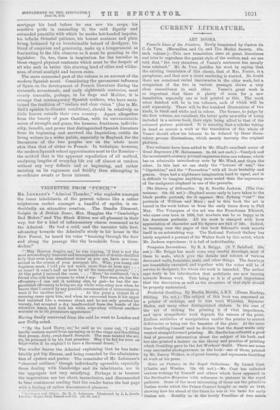CURRENT LITERATURE.
ART BOOKS.
Vasari's Lives of the Painters. Newly translated by Gaston du
C. do Vero, (Macmillan and Co. and Tim Medici Society. 25s. each volumo.)—This new translation aims at great literalness and tries to reproduce the quaint style of the author, and we are told that "the very structure of Vasari's sentences has usually been retained." Mr. de Vero justifies his work by saying that the existing translation of this classic, that of Mrs. Foster, is a paraphrase, and that now a closer rendering is wanted. No doubt there 'are occasional verbal inaccuracies in the older work, but a comparison of the two in various passages shows a very close resemblance to each other. Vasari's great work is so important that there is plenty of room for a new translation, especially one so well printed as this. The work when finished will be in ton volumes, each of which will ho sold separately. There will be five hundred illustrations of two kinds, in black and white and in colour. The former, to judge by the first volume, are excellent, the latter quite unworthy of being included in a serious book, their style being allied to that of the coloured picture post-card. It is amazing that a scholar taking in hand so serious a work as the translation of the whole of Vasari should allow his labours to be defaced by these three- colour process illustrations, which merely travesty the original. pictures.
Two volumes have been added to Mr. Hind's excellent series of
Great Engravers (W. Heinemann. 2s. 6d. net each.)—Vandyck and the seventeenth-century portrait engravers form one volume, which has an admirable introductory note by Mr. Hind, and Goya the other. In this last we can study the "horrors of war," the " Caprichies," and the " Proverbios " with all their brutality and genius. Goya had a nightmare imagination hard to equal, and it is difficult to imagine anything more weird than the expression of the malignant elephant in one of the proverbs.






















































 Previous page
Previous page